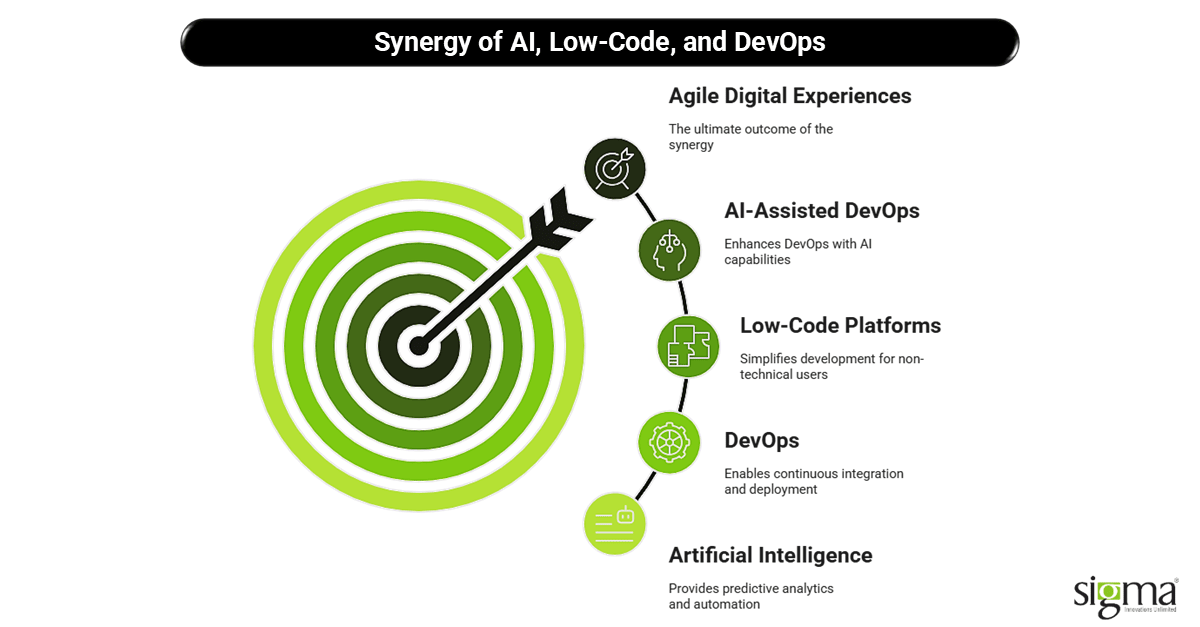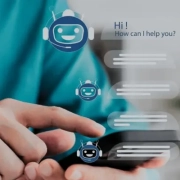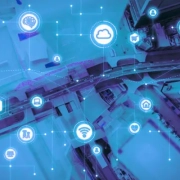AI, Low-Code, & DevOps: The Triad of Software Product Engineering Services

We’re living in a time where digital products aren’t just part of business—they are the business. Whether you’re a growing fintech startup, a global eCommerce brand, or any other B2B enterprise, one thing’s clear: speed, innovation, and lean operations are no longer nice-to-haves. They’re survival tools. And that’s exactly where modern software product engineering services step in.
In this race to stay ahead, three powerful forces have emerged as game changers: AI, Low-Code/No-Code platforms, and DevOps. Now, these may sound like just another set of tech buzzwords, but trust us—they’re more like the three legs of a sturdy tripod. When combined, they offer the kind of balance and support that today’s fast-moving digital businesses need.
Think of AI as the smart brain that drives intelligent automation and insights, Low-Code/No-Code as the speedy hands building and adapting solutions without heavy coding, and DevOps as the beating heart keeping everything moving efficiently from idea to delivery.
Together, this triad is reshaping how companies approach software product engineering, empowering businesses to launch faster, modernize smarter, and operate leaner. Whether it’s scaling a cloud-native app, streamlining workflows, or delivering delightful customer experiences, this fusion is opening new doors.
In this blog, we’ll break down how these emerging trends are pushing the boundaries of what’s possible in product engineering services and why embracing them could be your next smart business move.
What Is Software Product Engineering Today?
Let’s break it down: Software Product Engineering (SPE) is the end-to-end process of designing, developing, testing, deploying, and scaling digital products. But in today’s fast-paced digital economy, it’s evolved way beyond just writing code.
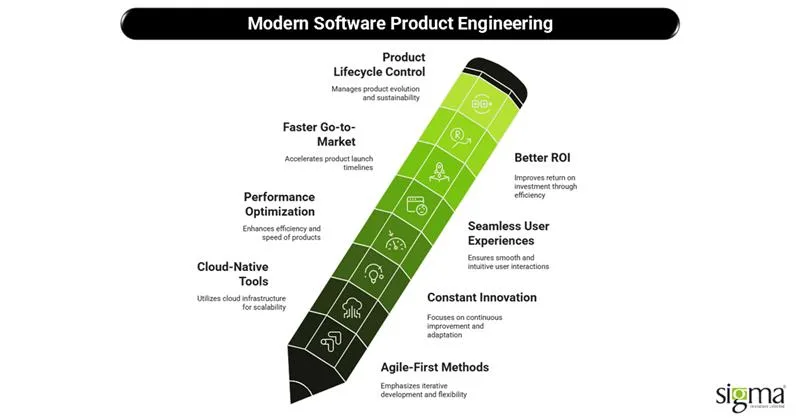
Modern software product engineering services are built around platforms, not projects. That means embracing agile-first methods, working in sprints, and using cloud-native tools to create scalable, flexible products that adapt as business needs change.
Gone are the days of “build once, run forever.” Today’s digital products need to be built fast, scale effortlessly, and be sustainable in the long run. That’s where product engineering solutions stand out—they focus on constant innovation, performance optimization, and seamless user experiences.
With rising customer expectations and ever-evolving technology stacks, companies are moving from rigid, traditional development models to leaner, smarter approaches. This shift to digital product engineering services means faster go-to-market, better ROI, and more control over product lifecycles.
Simply put, software product engineering is no longer just about code—it’s about creating lasting value.
How AI Is Rewriting the Rules of Software Product Engineering
Artificial Intelligence (AI) isn’t just making things faster—it’s making them smarter. Within the world of software product engineering, AI has stepped in as both a co-pilot and a catalyst, helping businesses build better digital products with less guesswork and more precision.

AI-Powered Tools That Do the Heavy Lifting
In software product engineering services, AI now plays a critical role across the entire development cycle. We’re talking everything from AI-powered code generation tools that help developers write cleaner code in record time, to smart debugging assistants that can catch and resolve bugs before they spiral into production issues.
Testing is also no longer the time sink it used to be. With automated QA frameworks powered by machine learning, teams can run hundreds of test cases simultaneously, identifying and resolving issues with minimal human input. Add predictive analytics to the mix, and product teams get real-time insights on how users interact with features, helping them prioritize what matters most.
Ready to revolutionize your product development with intelligent automation and real-time insights? Explore our Artificial Intelligence development services!
From Insights to Impact – Making Smarter Decisions
AI brings brains to product engineering solutions. With AI-based analytics, companies can dig deeper into user behavior, track trends, and understand patterns that influence product success. Think of it like having a supercharged GPS guiding your digital roadmap—less wandering, more targeted growth.
On the back end, machine learning models are now used for predictive maintenance, spotting potential failures in infrastructure before they occur. That’s peace of mind you can’t put a price on—especially when you’re supporting millions of users across platforms.
In customer-facing applications, AI-driven product engineering is helping tailor experiences in real time. Adaptive UI/UX personalization—where the product interface changes based on how users behave—is no longer science fiction. It’s happening now, and it’s driving higher engagement and retention.
Why Businesses Are Going All-In on AI
Let’s face it: in today’s hyper-competitive environment, faster time-to-market is everything. With AI taking over repetitive, time-consuming tasks, development teams can move faster while maintaining quality.
AI also boosts developer productivity by cutting down the time spent on troubleshooting, documentation, and manual testing. It’s like giving your team an extra set of super-smart hands and eyes.
And perhaps most importantly, AI enables automated QA and intelligent error resolution—freeing up human brainpower for strategic, high-impact tasks.
42% of businesses are leveraging AI for product development. This underscores AI’s escalating influence and adoption across industries.
Real-World Impact
Many companies today are integrating AI into their CI/CD pipelines, enabling seamless, automated deployments and continuous optimization. From fintech platforms that use AI to predict user churn, to eCommerce businesses personalizing product recommendations with machine learning, the impact is clear.
AI isn’t just an add-on to digital product engineering services—it’s fast becoming the backbone. It’s pushing the boundaries of what we once thought possible in product modernization and re-engineering, especially when paired with microservices in product development and cross-platform development frameworks.
Low-Code/No-Code: The Fast Lane of Software Product Engineering
In today’s fast-moving digital world, speed is everything—and Low-Code/No-Code (LCNC) platforms are making it possible for businesses to build and test apps in a fraction of the time it used to take. These platforms are now a core part of modern software product engineering services, giving both developers and non-developers a quicker, more flexible way to innovate.
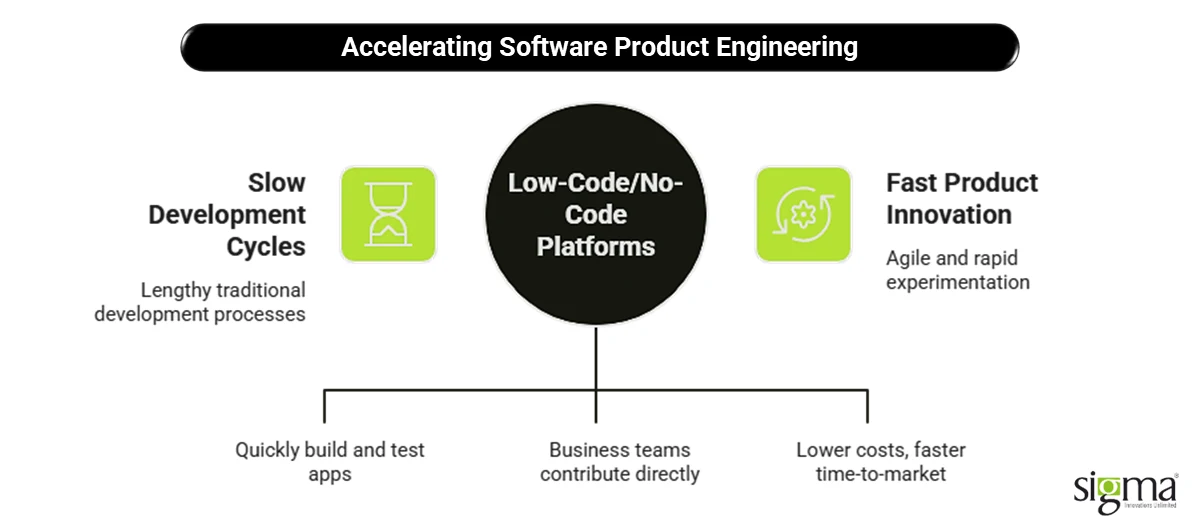
What Is Low-Code/No-Code, Really?
Low-Code platforms let you build apps with minimal hand-coding by using drag-and-drop components and visual workflows. No-Code takes it a step further, allowing users with zero programming experience to create functional applications.
At the heart of these platforms are pre-built modules, reusable components, and intuitive user interfaces. Together, they help teams spin up prototypes, dashboards, and tools without waiting weeks for traditional development cycles to play out.
This approach is especially useful in digital product engineering services, where agility is the name of the game .
Explore our App Development Services to see how low-code/no-code, combined with expert engineering, can transform your digital strategy!
Where Enterprises Are Using LCNC
B2B companies are turning to Low-Code/No-Code for use cases that demand quick results without compromising quality. Want to build a minimum viable product (MVP) fast? LCNC is your go-to. Need to roll out internal tools or admin portals for your ops team? Done in days, not months.
Enterprises are also using LCNC platforms for workflow automation, customer-facing apps, and data dashboards—all while keeping development costs in check.
In short, this approach enables rapid experimentation and easier iteration, a huge win for businesses investing in product engineering solutions.
Big Wins, Fewer Bottlenecks
Perhaps the most exciting benefit is the democratization of development. Now, business analysts, marketers, and operations teams can contribute directly to building digital tools—something that used to be locked behind layers of dev teams.
By reducing the need for full-stack development talent on every single project, companies see lower costs and faster time-to-market. And when paired with AI-driven product engineering or DevOps pipelines, LCNC becomes even more powerful.
But It’s Not Without Challenges
Of course, LCNC isn’t a silver bullet. As useful as these platforms are, businesses still need to address security and governance—especially when handling sensitive customer data or financial workflows.
Another key consideration is integration with legacy systems. Not all platforms play nicely with older tech stacks, which can create roadblocks for scalability and reliability.
Still, with the right strategy, low-code/no-code platforms are becoming a cornerstone of software product engineering, especially for businesses pushing toward product modernization and re-engineering.
DevOps: The Backbone of Agile Software Product Engineering
If AI is the brain and Low-Code the fast hands, then DevOps is the strong spine holding it all together in the world of software product engineering. It’s not just a practice—it’s a culture, a mindset, and the operational glue that binds innovation and execution.
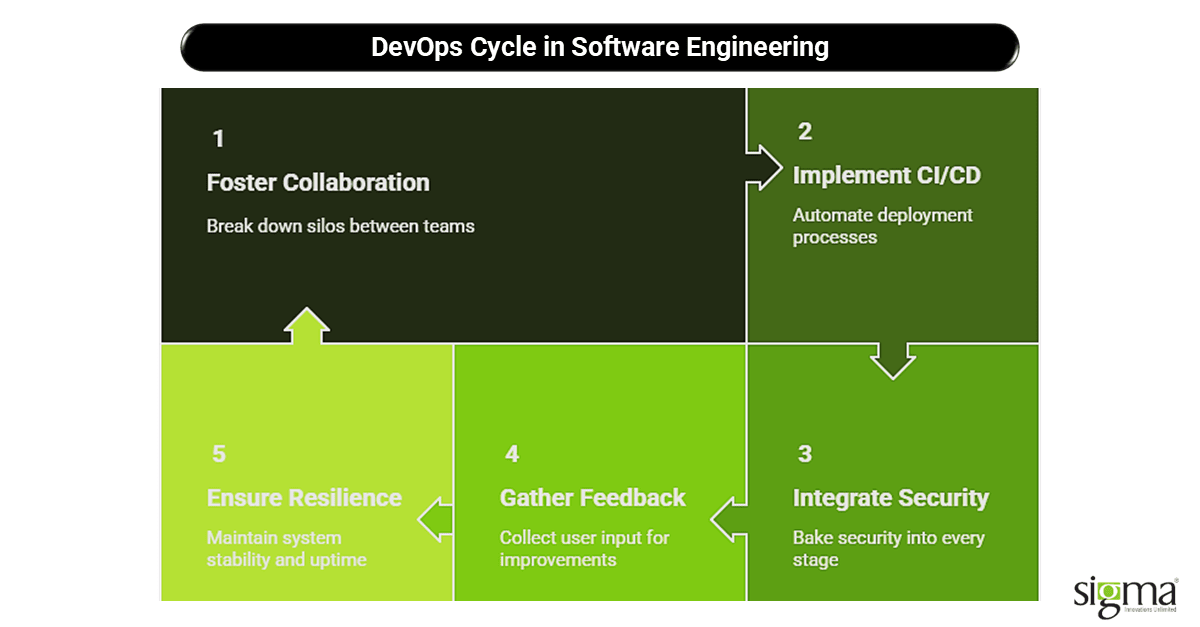
DevOps – The Enabler of the Triad
Modern software product engineering services depend heavily on DevOps to keep things moving efficiently. Why? Because DevOps fosters collaboration between development and operations teams, breaking down the silos that used to slow everything down.
With seamless CI/CD pipelines, businesses can push updates, roll back issues, and deliver new features without bottlenecks. This is essential when working with AI-driven product engineering models or Low-Code/No-Code solutions, where rapid iteration is key.
DevOps also introduces Infrastructure as Code (IaC)—letting teams create, manage, and replicate entire environments with the push of a button. It’s like building a house from a blueprint instead of scratch each time—faster, more scalable, and easier to manage.
DevSecOps – Building Security Into the Process
Security is no longer a post-launch checkpoint. With DevSecOps, security gets baked into every stage of the software development life cycle (SDLC)—from design and build to deployment and maintenance.
Using AI and machine learning, teams can now predict threats, detect anomalies, and respond to security risks before they escalate. For businesses working in fintech or eCommerce, this proactive approach is crucial to maintaining user trust and regulatory compliance.
Why DevOps Matters More Than Ever
Adopting DevOps means faster releases without sacrificing stability. Businesses benefit from:
- Reduced time-to-release: Frequent, automated deployments help companies stay ahead of the market curve.
- Continuous feedback loops: Monitoring, testing, and user input are integrated into every cycle, leading to smarter product decisions.
- Resilient architecture: If something goes down, it’s fixed fast—often before end-users even notice.
Combined with microservices in product development, DevOps ensures that individual components of a product can be updated or scaled without impacting the whole system.
In short, DevOps is the bedrock of digital product engineering services—powering agility, security, and sustainability in every release.
The Synergy: AI, Low-Code, and DevOps in Perfect Harmony
When you look at AI, Low-Code, and DevOps individually, each plays a powerful role in software product engineering. But when they come together? That’s where the real magic happens. Think of them like a jazz trio—each brilliant on their own, but together they create a rhythm of innovation that’s hard to beat.
How They Connect and Reinforce Each Other
Let’s start with DevOps—the engine that keeps things moving. Without DevOps, deploying AI models or Low-Code solutions at scale would be like trying to race a car without wheels. CI/CD pipelines enable faster integration of AI-powered tools and Low-Code applications, turning them into business-ready solutions, fast.
On the flip side, AI improves DevOps workflows through predictive failure detection and smart anomaly alerts. This leads to smarter monitoring, faster issue resolution, and more resilient architecture—essential ingredients in any high-performing product engineering solution.
And here’s where it gets really interesting: Low-Code platforms are now embedding DevOps tools natively. That means business teams—marketing, ops, finance—can push updates, track issues, and even roll out automation flows without writing custom scripts.
This interconnected setup gives companies a serious edge in building scalable, agile digital experiences through digital product engineering services.
Emerging Trends and Patterns
This convergence is giving rise to exciting new practices and tools:
- AIOps (AI-assisted DevOps): DevOps powered by AI to manage performance, detect issues early, and automate resolutions.
- Low-Code DevOps platforms: Tools like OutSystems and Mendix now come with built-in DevOps capabilities, helping non-technical users manage version control, staging, and releases.
- AI-driven testing for Low-Code apps: Using machine learning to test user paths, simulate errors, and validate performance—without manually writing test scripts.
These emerging patterns are pushing AI-driven product engineering to new heights, while also making cross-platform development frameworks and product modernization and re-engineering far more accessible and effective.
How It All Works Together – A Real-World Example
Let’s say a retail company wants to launch a personalized customer rewards platform:
- A low-code platform is used to build the MVP in a week, utilizing drag-and-drop workflows and prebuilt modules.
- AI models are embedded to analyze customer data and predict the optimal timing and offers for rewards.
- DevOps pipelines continuously integrate and deploy the solution, with auto-testing and rollback features in place.
- AI-assisted DevOps (AIOps) monitors the system in real-time, flagging any unusual user behaviors or performance dips.
- Business teams use the Low-Code dashboard to make updates and view analytics—all without touching the core code.
That’s what modern software product engineering services look like—agile, intelligent, and business-ready.
Bonus content! Read to know more about why product-led growth needs scalable product engineering services.
Making It Work: Strategic Implementation for Enterprises
Embracing the triad of AI, Low-Code, and DevOps is more than a tech upgrade—it’s a strategic move. But to make it stick, enterprises need a thoughtful game plan for successful implementation within their software product engineering framework.
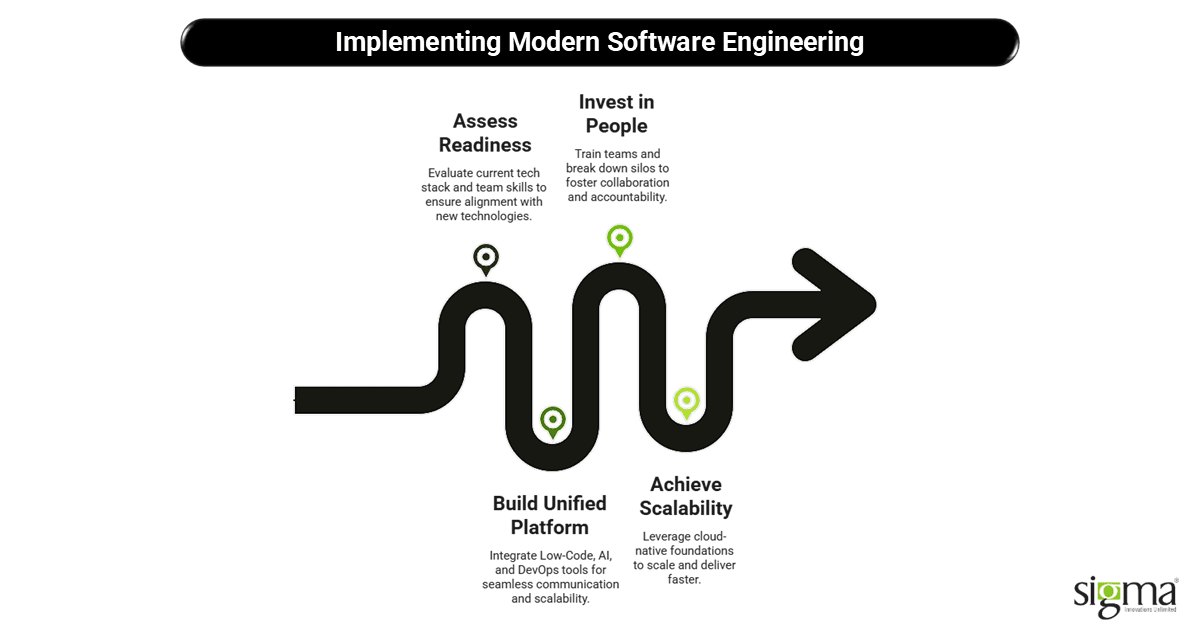
Step 1 – Assess Readiness
Before jumping in, assess your current state—your tech stack, your team’s skill levels, and your operational maturity. Is your infrastructure flexible enough for cloud-native architecture? Do your teams understand the basics of DevOps pipelines or how AI-driven product engineering fits into their workflow?
Step 2 – Build a Unified Platform Strategy
The key to success lies in integration. Choose platforms that allow seamless communication between Low-Code tools, AI services, and DevOps frameworks. This prevents fragmented workflows and enables smoother scaling of your product engineering solutions.
Step 3 – Invest in People
AI and DevOps don’t run themselves. Invest in AI governance, DevOps training, and empower cross-functional teams. Breaking down silos between business and tech teams encourages better collaboration, faster decisions, and more accountability.
By tying all of this together with a cloud-native foundation, you gain the flexibility to scale, experiment, and deliver faster.
With a smart implementation roadmap, enterprises can truly unlock the power of modern software product engineering services—not just in theory, but in everyday impact.
Common Pitfalls When Adopting the Triad
While AI, Low-Code, and DevOps offer tremendous benefits, they’re not without their challenges. For enterprises adopting modern software product engineering services, understanding these pitfalls early can make all the difference between smooth scaling and digital headaches.
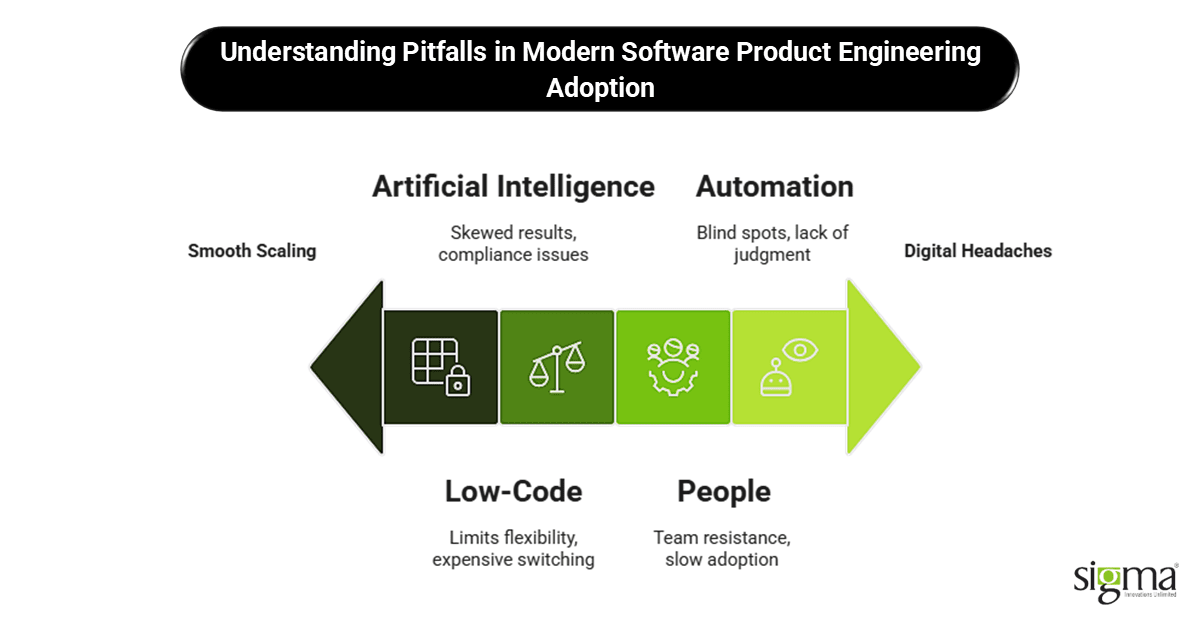
Vendor Lock-In – The Low-Code Trap
Low-Code platforms offer speed, but they sometimes come at the cost of flexibility. Once you build your product around a specific vendor’s ecosystem, switching platforms—or even customizing beyond their limits—can get tricky and expensive. For businesses focused on long-term scalability through digital product engineering services, evaluating platform portability and integration flexibility is critical.
AI Bias and Black Box Decisions
With AI-driven product engineering, transparency matters. Machine learning models often operate like black boxes, making decisions without clear explanations. This lack of AI explainability can lead to compliance issues and trust gaps—especially in regulated industries like finance or healthcare.
Worse, if your AI models are trained on biased data, they can deliver skewed or even discriminatory results. Building responsible, ethical AI into your product engineering solutions is no longer optional—it’s essential.
Change Management – It’s a People Thing
Technology can evolve fast, but people don’t always move at the same pace. Shifting to an AI + DevOps + Low-Code setup demands a culture shift. Teams may resist new workflows, fear automation, or struggle to learn new tools. That’s why leadership must prioritize cross-functional team alignment, training, and clear communication.
Change management isn’t just about tools—it’s about trust.
Over-Reliance on Automation
Yes, automation is great—until it becomes a crutch. While DevOps and AI enable incredible efficiencies in software product engineering, over-automating critical functions without human oversight can lead to blind spots. Whether it’s automated testing, deployment, or data analysis, there’s always a need for smart human judgment to step in when things go sideways.
The Future of Software Product Engineering
The world of software product engineering isn’t just evolving—it’s accelerating into a smarter, more modular future. For enterprises looking to stay ahead, the question isn’t whether to adapt—it’s how fast you can.
Platform Engineering Is Gaining Ground
One major shift is the rise of platform engineering—where internal developer platforms (IDPs) are built to standardize and streamline development, deployment, and monitoring. Think of it as building the foundation of a city before inviting developers to construct skyscrapers. It’s becoming a key capability in modern software product engineering services, enabling consistent and scalable outcomes across teams.
AI-Native Development Is Around the Corner
The integration of AI-driven product engineering will move beyond just tools and assistants. We’re entering the era of AI-native development environments—where machine learning isn’t just a plug-in but baked directly into IDEs, testing suites, and CI/CD pipelines. From generating smart code snippets to debugging in real time, AI will be a developer’s co-pilot, not just an accessory.
Composable, Intelligent Architectures
Gone are the days of monolithic builds. The shift is toward composable architectures—think plug-and-play functionality that’s smart, scalable, and flexible. With the rise of microservices in product development, edge computing, and product design, products will become more adaptable, user-driven, and context-aware.
As these trends take shape, enterprises will need digital product engineering services that are forward-thinking, agile, and strategically aligned to modern tech ecosystems . Ready to transform your vision into cutting-edge products? Explore our Software Product Engineering Services and accelerate your journey into the future of innovation.
The Triad That Defines the Future
In today’s high-speed digital economy, AI, Low-Code, and DevOps are no longer optional—they’re mission-critical. These three forces are redefining how businesses design, develop, and deliver software. They are the pillars of modern software product engineering services, and companies that harness this triad effectively are not just keeping up—they’re setting the pace.
AI accelerates decision-making, personalizes user experiences, and automates everything from coding to security. Low-Code democratizes innovation, empowering teams across the enterprise to build and launch digital products fast. And DevOps glues it all together—enabling agility, speed, and stability through continuous delivery and integration.
Together, they don’t just add value—they multiply it. They help build smarter architectures, shorten time-to-market, and unlock true digital agility.
Here’s the truth: mastering this triad doesn’t just improve efficiency—it defines market leadership. As the shift toward platform engineering, AI-native development, and intelligent, composable architectures continues, businesses must rethink how they engage with digital product engineering services.
Ready to lead the next wave of software innovation?
Let’s build your future-ready digital products together. Talk to our experts today and discover how our software product engineering services can accelerate your business.
